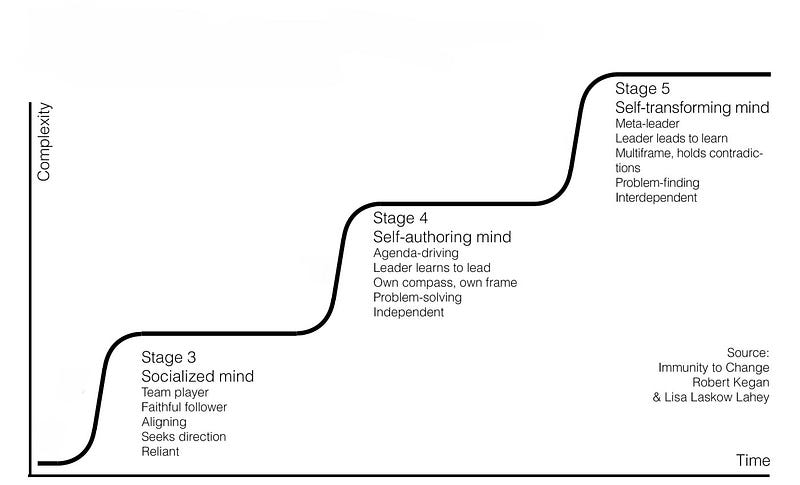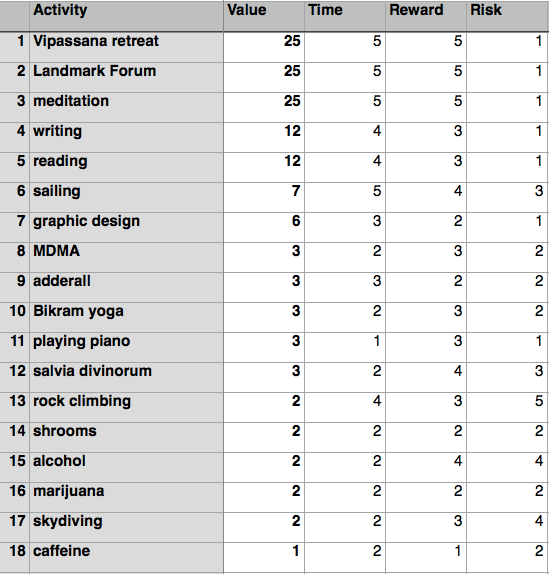A year ago in Productivity for Precious Snowflakes, I introduced the idea of Mood-First Productivity — that our moods, or unique states of mind, are fundamental drivers of creative knowledge work.
But something was missing: how does one advance in the practice of Mood-First Productivity, besides noticing what mood you’re in at any given time, and trying to accommodate it?
This hints at a more fundamental question: are unique states of mind just defense, an attempt to make the best of what we’re given? Or can they also be used on offense — to gain deep insights, explore new ways of being, and push through self-imposed barriers?
I finished a book this week that shed a lot of light on this question, through its exploration of “non-ordinary states of consciousness”: Stealing Fire (affiliate link), by Steven Kotler and Jamie Wheal. It proposes that the ability to enter altered states of mind at will is the key to breaking free of the shackles of the pre-frontal cortex, which houses our reasoning and planning capabilities, but also our inner critic and perceptual filters.
For the first time in history, the book argues, we are witnessing the mainstream acceptance of such altered states, as well as a wide range of activities, triggers, environments, and substances that can be used to get there.

The ancient Greeks called it ecstasis — “stepping beyond oneself.” It featured prominently in their (in)famous nine-day ritual known as the Eleusinian Mysteries. Pop psychology refers to it simply as “flow.”
The activities or experiences that produce altered mental states are extremely diverse, but could be placed into 4 main categories:
- Flow states (being “in the zone”): action sports, bio and neurofeedback, mindfulness-based stress reduction, martial arts, sensory deprivation tanks, breathwork, transcranial magnetic stimulation, dance
- Contemplative and mystical states: meditation, near-death experiences, yoga
- Psychedelic states: MDMA, psilocybin, ketamine, marijuana
- Communal states: Landmark, Tony Robbins, Burning Man, concerts, chanting, alternative sexuality
I take issue with the overly broad definition the authors use for the $4 trillion-dollar “Altered States Economy,” in which they include porn, video games, and even junk food. But limiting our discussion to the activities listed above, there does seem to be a common pattern in the neurology that accompanies such experiences:
- norepinephrine and dopamine amplify focus, muscle reaction times, and pattern recognition
- brainwaves slow from agitated beta to calmer alpha, putting us in a relaxed yet alert mode, with less internal resistance
- parts of the prefrontal cortex begin shutting down, quieting our inner critic, dissolving our sense of time and space, and reducing our focus on the past and future
- endorphins and anandamide reduce physical pain and boost lateral thinking
- theta brainwaves arise, normally produced only during REM sleep
- afterglow of serotonin and oxytocin, prompting feelings of peace, well-being, and sociability
Kotler and Wheal argue that humans have always sought easy ways to get high, but that for the first time, due to relaxing taboos and wider availability of the required technology, these experiences are going mainstream.
They cite numerous examples:
- OneTaste (an “orgasmic meditation” practice) made the list of the 500 fastest-growing companies in the country in 2015
- Nearly one in ten Americans report using psychedelics on a regular basis
- The spread of Burning Man-style gatherings to “regional burns” and music festivals around the world
- The explosive growth of the Consciousness Hacking community, which started in Silicon Valley and has now spread to Meetup groups around the world
- The most impressive example of mainstream adoption is probably meditation, which has followed in the footsteps of yoga to become so popular that 18 million Americans report a regular practice, and 44% of all U.S. companies will offer mindfulness training to their employees by the end of 2017
Now here’s the question: how would someone use such altered mental states to increase their performance?
The work of Harvard psychologist Robert Kegan provides a possible answer. His influential theory lays out 5 stages of development in adults. At each stage, we undergo what he calls a “subject-object shift.” What previously seemed to be inseparable from our identity — our emotions, our interests, our relationships, our beliefs — is revealed in the next stage to be merely a “mental object,” which can be named, looked at, and evaluated objectively.
For example, at Stage 3 we identify very closely with our emotions, and therefore can’t distinguish between them or view them objectively. We become flooded by the emotions of others, making it difficult to respond appropriately. Once we undergo a subject-object shift to the next stage, emotions become something we have, not something we are. This gives us greater freedom and flexibility in responding to life’s challenges.

Many studies have confirmed that development along these stages correlates to real-world success: 80% of those scoring in the upper two stages hold senior management roles despite making up only 10% of the population. This only serves to emphasize how few make it that far — estimates of how many people make it to Stage 5 range from less than 1% to 5% at most.
Altered states of mind offer the possibility of increasing performance by making the subject-object shift to the next stage easier, giving someone more self-awareness, flexibility, and leverage in their work. They enable anamnesis — the “forgetting of the forgetting” — allowing us to put down the hammer that we bring to every problem: ordinary waking consciousness.
Kotler and Wheal cite the research of UCLA psychopharmacologist Ronald K. Siegel, who has documented so many examples of willful intoxication among wild animals, that he has come to believe that “the pursuit of intoxication with drugs is a primary motivational force in organisms.” But such experiences clearly have risks, and costs. What benefit could they provide that would justify them?
There seem to be 4 possible candidates:
Greater satisfaction
There is evidence that flow produces some of the most pleasurable and moving states we are capable of. In a study at Stanford, subjects who experienced even a brief moment of timelessness “felt they had more time available, were less impatient, more willing to volunteer to help others, more strongly preferred experiences over material products, and experienced a greater boost in life satisfaction.”
Faster information processing
As the pre-frontal cortex slows down during experiences of flow, energy usually dedicated to tracking time gets reallocated to focus and attention. The book cites studies showing that using transcranial magnetic stimulation to induce flow resulted in an eightfold improvement in pattern-matching exercises in one group, and neurofeedback devices produced a 490% improvement in problem solving by a group of soldiers.
Accelerated learning
Longtime meditators have long been known to produce gamma brainwaves, which are normally produced during “binding” — when novel ideas come together for the first time and carve new neural pathways. The authors report that the use of sensory deprivation tanks combined with language immersion has enabled the Navy SEALS to reduce language learning time from 6 months to 6 weeks.
Depatterning
But by far the most interesting one is depatterning. Siegel and other researchers have proposed that the evolutionary function of pursuing altered states of mind is “undoing” patterns of thinking and acting that no longer serve us. This serves as a counter-force to the conservatism of our day-to-day mental machinery, which can hold on to habits far past their usefulness.
The pursuit of altered mental states could be our way of unlearning counterproductive mental patterns, enabling a subject-object shift that opens us up to new ways of being. This makes sense — what pattern is more difficult to unlearn than your very identity? By disassociating our “selves” from our state of mind, and realizing that a state of mind is something we have, not something we are, these experiences may allow us to spin up and deploy different states like software programs best suited to specific problems.
Here is where we return to the world of work: what could be more valuable in our modern economy than depatterning? Massive companies fail because they can’t change with the times. Startups implode because they can’t pivot fast enough. Maybe individuals get spun out of the job market not because they can’t learn new skills, but because they can’t unlearn old ones?
Caveats
There are caveats to anything so powerful, of course.
The first is the lingering taboo against such activities. People like Steve Jobs can discuss their psychedelic experiences publicly, but for most others it remains something to be kept discreet.
The second is the potential risks inherent in “losing one’s mind.” From the persuasion of digital marketing, to the coercion of military orders, to the cult-like tendencies of any group seeking to change behavior en masse, it would be foolish to pretend that these methods can’t be used for manipulation and coercion.
But the third caveat is, I believe, the most subtle, and thus the most challenging: the perception of these pursuits as being only for “experience junkines,” a “weird California thing,” or a form of “spiritual bypassing,” a term coined by psychologist John Welwood that refers to the “…widespread tendency to use spiritual ideas and practices to sidestep or avoid facing unresolved emotional issues, psychological wounds, and unfinished developmental tasks.”
These views are perfectly encapsulated in this hilarious parody of “biohacking.:
But there’s also a risk to having too much caution. Branding an entire realm of human experience as “beyond the pale” denies the benefits of these experiences to many. I see the emergence of an “experiential 1%” — a cognitive elite who have the time, money, connections, emotional maturity, and cognitive dexterity to undertake these activities, and the resources and support systems to protect them from the excesses and downsides.
They are able to reap the rewards of greater satisfaction, faster information processing, accelerated learning, and depatterning, using them to produce new ideas, products, and services whose upsides are ever greater due to technology and globalization. Meanwhile, the conservative masses are “protected” from the downsides of altered states of consciousness, while also being denied their benefits.
The irony of writing off altered states of consciousness as coercive and cultish is that you become that much more susceptible to the state-sanctioned cults: capitalism, consumerism, nationalism, patriotism, individualism, rationalism. In the same way that teaching abstinence-only sex education only makes young people more susceptible when the real thing comes along.
Could it be that kenosis, or “self-emptying,” is the secret to 10x performance, precisely because so few are willing to step out of their favorite -isms, even for a moment?
The Ecstasis Equation
Toward the end of the book, Kotler and Wheal offer an Ecstasis Equation as a way to catalog and compare alternative states of consciousness:
Value = Time x Reward/Risk
The idea is that the value of an experience is a function of the time it requires to reliably reproduce the altered state, how positive and long-lasting the rewards of that state are, and the risk involved in the activity.
I made a list of my own such experiences, assigning each variable a rating from 1 to 5 (5 is highest) and then sorting them according to total value, based on the equation above:

Assigning these ratings was itself an interesting exercise. I had to invent some rules:
- “reward” is a combination of the quality of insights generated, and how well the activity helps me “get out of my head”
- “time” takes into account both how long it takes to learn the activity initially, plus the time it takes to get back into it when desired
- I only included activities that I had significant experience with
I also noticed a few problems with the equation:
- It seems to imply that the more time something takes, the more value it provides. While that’s not true, it’s also not true that the more time something takes, the less value it provides
- While the ranking generally makes sense, it’s too sensitive (i.e. I don’t think meditation is 8x more insightful than salvia)
- It’s very difficult to compare the quality or kind of insight one gains from a discreet experience (like one-time events and substances), and that gained from a long-running practice (like meditation or a sport)
In a followup article, I’ll connect the ideas discussed here to other sources and examples, in an attempt to build a more nuanced and scientifically grounded model for this type of unlearning.
In the meantime, would any of you be willing to rate your own experiences according to the methodology above, and share them with me?
Click here to download the Excel spreadsheet above, with formulas. You can email it to me directly at [email protected] if you don’t feel comfortable posting here, and I will keep strict confidentiality.
Follow us for the latest updates and insights around productivity and Building a Second Brain on Twitter, Facebook, Instagram, LinkedIn, and YouTube. And if you’re ready to start building your Second Brain, get the book and learn the proven method to organize your digital life and unlock your creative potential.
- POSTED IN: Attention, Book summary, Books, Cognitive science, Education, Emotions, Flow, Personal growth
